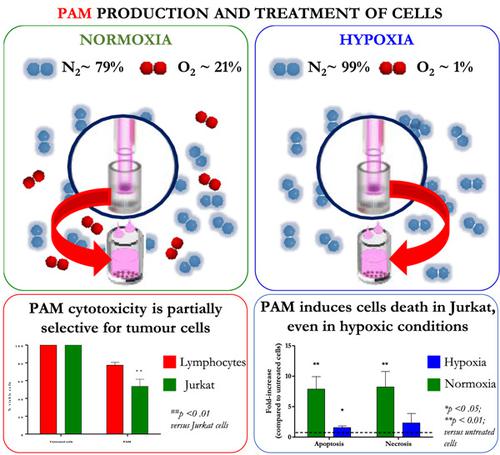当前位置:
X-MOL 学术
›
Plasma Processes Polym.
›
论文详情
Our official English website, www.x-mol.net, welcomes your
feedback! (Note: you will need to create a separate account there.)
Plasma‐activated medium as an innovative anticancer strategy: Insight into its cellular and molecular impact on in vitro leukemia cells
Plasma Processes and Polymers ( IF 2.9 ) Pub Date : 2020-04-20 , DOI: 10.1002/ppap.202000007 Eleonora Turrini 1 , Romolo Laurita 2, 3 , Emanuele Simoncelli 2 , Augusto Stancampiano 2 , Elena Catanzaro 1 , Cinzia Calcabrini 1 , Giovanni Carulli 4 , Martina Rousseau 4 , Matteo Gherardi 2, 3 , Francesca Maffei 1 , Veronica Cocchi 5 , Monia Lenzi 5 , Valentina Pellicioni 1 , Patrizia Hrelia 5 , Vittorio Colombo 2, 3 , Carmela Fimognari 1
Plasma Processes and Polymers ( IF 2.9 ) Pub Date : 2020-04-20 , DOI: 10.1002/ppap.202000007 Eleonora Turrini 1 , Romolo Laurita 2, 3 , Emanuele Simoncelli 2 , Augusto Stancampiano 2 , Elena Catanzaro 1 , Cinzia Calcabrini 1 , Giovanni Carulli 4 , Martina Rousseau 4 , Matteo Gherardi 2, 3 , Francesca Maffei 1 , Veronica Cocchi 5 , Monia Lenzi 5 , Valentina Pellicioni 1 , Patrizia Hrelia 5 , Vittorio Colombo 2, 3 , Carmela Fimognari 1
Affiliation

|
Cold atmospheric plasma (CAP) has received attention as a potential anticancer strategy. In this study, culture medium was exposed to a microsecond‐pulsed dielectric barrier discharge jet to produce plasma‐activated medium (PAM). On the T‐lymphoblastic cell line, PAM induced apoptosis through the activation of the intrinsic pathway and inhibited the cell‐cycle progression. The use of the scavengers N‐acetylcysteine or O‐phenantroline significantly decreased the PAM proapoptotic activity. The genetic impact of PAM on TK6 cells was assessed, resulting in an increased micronuclei frequency. PAM exhibited cytotoxic effects even on leukemia cells cultivated in hypoxia, which plays a critical role in promoting chemoresistance. PAM was also tested on normal lymphocytes, showing its partial selectivity. Taken together, these results contribute to understand the pharmacotoxicological profile of CAP.
中文翻译:

血浆活化培养基作为一种创新的抗癌策略:洞悉其细胞和分子对体外白血病细胞的影响
寒冷的大气血浆(CAP)作为一种潜在的抗癌策略已受到关注。在这项研究中,将培养基暴露于微秒脉冲的介电屏障放电射流,以产生血浆活化培养基(PAM)。在T淋巴细胞细胞系上,PAM通过激活内在途径诱导凋亡,并抑制细胞周期进程。使用清除剂N-乙酰半胱氨酸或O菲咯啉可显着降低PAM的凋亡活性。评估了PAM对TK6细胞的遗传影响,从而导致微核频率增加。PAM甚至对低氧培养的白血病细胞也具有细胞毒性作用,这在促进化学抗性中起着关键作用。还对正常淋巴细胞测试了PAM,显示了其部分选择性。综上所述,这些结果有助于理解CAP的药物毒理学特征。
更新日期:2020-04-20
中文翻译:

血浆活化培养基作为一种创新的抗癌策略:洞悉其细胞和分子对体外白血病细胞的影响
寒冷的大气血浆(CAP)作为一种潜在的抗癌策略已受到关注。在这项研究中,将培养基暴露于微秒脉冲的介电屏障放电射流,以产生血浆活化培养基(PAM)。在T淋巴细胞细胞系上,PAM通过激活内在途径诱导凋亡,并抑制细胞周期进程。使用清除剂N-乙酰半胱氨酸或O菲咯啉可显着降低PAM的凋亡活性。评估了PAM对TK6细胞的遗传影响,从而导致微核频率增加。PAM甚至对低氧培养的白血病细胞也具有细胞毒性作用,这在促进化学抗性中起着关键作用。还对正常淋巴细胞测试了PAM,显示了其部分选择性。综上所述,这些结果有助于理解CAP的药物毒理学特征。











































 京公网安备 11010802027423号
京公网安备 11010802027423号